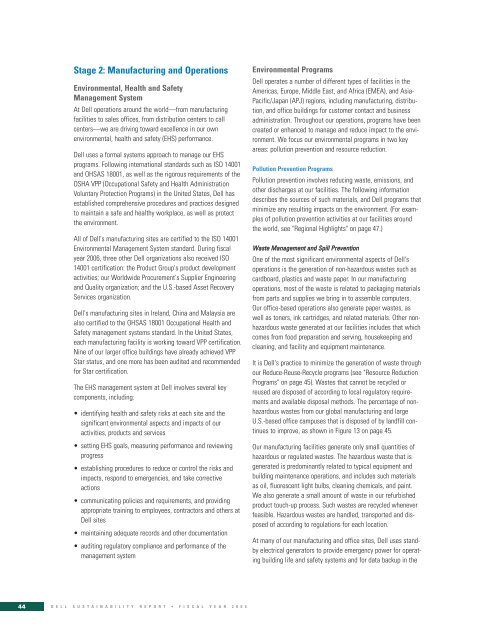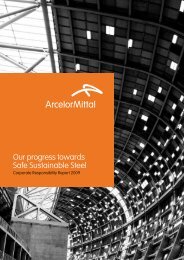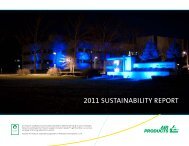Sustainability Report - Dell
Sustainability Report - Dell
Sustainability Report - Dell
Create successful ePaper yourself
Turn your PDF publications into a flip-book with our unique Google optimized e-Paper software.
Stage 2: Manufacturing and OperationsEnvironmental, Health and SafetyManagement SystemAt <strong>Dell</strong> operations around the world—from manufacturingfacilities to sales offices, from distribution centers to callcenters—we are driving toward excellence in our ownenvironmental, health and safety (EHS) performance.<strong>Dell</strong> uses a formal systems approach to manage our EHSprograms. Following international standards such as ISO 14001and OHSAS 18001, as well as the rigorous requirements of theOSHA VPP (Occupational Safety and Health AdministrationVoluntary Protection Programs) in the United States, <strong>Dell</strong> hasestablished comprehensive procedures and practices designedto maintain a safe and healthy workplace, as well as protectthe environment.All of <strong>Dell</strong>'s manufacturing sites are certified to the ISO 14001Environmental Management System standard. During fiscalyear 2006, three other <strong>Dell</strong> organizations also received ISO14001 certification: the Product Group's product developmentactivities; our Worldwide Procurement's Supplier Engineeringand Quality organization; and the U.S.-based Asset RecoveryServices organization.<strong>Dell</strong>'s manufacturing sites in Ireland, China and Malaysia arealso certified to the OHSAS 18001 Occupational Health andSafety management systems standard. In the United States,each manufacturing facility is working toward VPP certification.Nine of our larger office buildings have already achieved VPPStar status, and one more has been audited and recommendedfor Star certification.The EHS management system at <strong>Dell</strong> involves several keycomponents, including:• identifying health and safety risks at each site and thesignificant environmental aspects and impacts of ouractivities, products and services• setting EHS goals, measuring performance and reviewingprogress• establishing procedures to reduce or control the risks andimpacts, respond to emergencies, and take correctiveactions• communicating policies and requirements, and providingappropriate training to employees, contractors and others at<strong>Dell</strong> sites• maintaining adequate records and other documentation• auditing regulatory compliance and performance of themanagement systemEnvironmental Programs<strong>Dell</strong> operates a number of different types of facilities in theAmericas, Europe, Middle East, and Africa (EMEA), and Asia-Pacific/Japan (APJ) regions, including manufacturing, distribution,and office buildings for customer contact and businessadministration. Throughout our operations, programs have beencreated or enhanced to manage and reduce impact to the environment.We focus our environmental programs in two keyareas: pollution prevention and resource reduction.Pollution Prevention ProgramsPollution prevention involves reducing waste, emissions, andother discharges at our facilities. The following informationdescribes the sources of such materials, and <strong>Dell</strong> programs thatminimize any resulting impacts on the environment. (For examplesof pollution prevention activities at our facilities aroundthe world, see "Regional Highlights" on page 47.)Waste Management and Spill PreventionOne of the most significant environmental aspects of <strong>Dell</strong>'soperations is the generation of non-hazardous wastes such ascardboard, plastics and waste paper. In our manufacturingoperations, most of the waste is related to packaging materialsfrom parts and supplies we bring in to assemble computers.Our office-based operations also generate paper wastes, aswell as toners, ink cartridges, and related materials. Other nonhazardouswaste generated at our facilities includes that whichcomes from food preparation and serving, housekeeping andcleaning, and facility and equipment maintenance.It is <strong>Dell</strong>'s practice to minimize the generation of waste throughour Reduce-Reuse-Recycle programs (see "Resource ReductionPrograms" on page 45). Wastes that cannot be recycled orreused are disposed of according to local regulatory requirementsand available disposal methods. The percentage of nonhazardouswastes from our global manufacturing and largeU.S.-based office campuses that is disposed of by landfill continuesto improve, as shown in Figure 13 on page 45.Our manufacturing facilities generate only small quantities ofhazardous or regulated wastes. The hazardous waste that isgenerated is predominantly related to typical equipment andbuilding maintenance operations, and includes such materialsas oil, fluorescent light bulbs, cleaning chemicals, and paint.We also generate a small amount of waste in our refurbishedproduct touch-up process. Such wastes are recycled wheneverfeasible. Hazardous wastes are handled, transported and disposedof according to regulations for each location.At many of our manufacturing and office sites, <strong>Dell</strong> uses standbyelectrical generators to provide emergency power for operatingbuilding life and safety systems and for data backup in the44 D E L L S U S T A I N A B I L I T Y R E P O R T • F I S C A L Y E A R 2 0 0 6
















